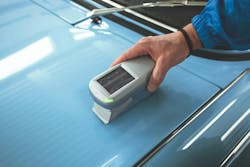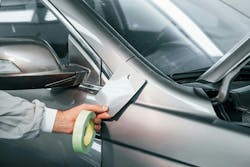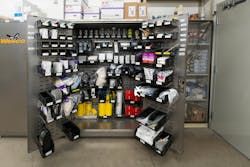As the last stop for a vehicle when moving through the repair process before reassembly occurs, the paint shop is often referred to as the “bottleneck” of a collision repair center. The truth is that every vehicle will need to go through the paint department at the appropriate stage of the repair process. To better enhance throughput and productivity, collision repair facilities should take the time to prepare and implement a standard operating procedure (SOP) to help address the bottlenecks that can occur.
Consider these solutions to include in your own SOPs to help with efficiently moving cars through the shop and work toward minimizing future bottlenecks.
1) Color, Color, Color
The most important step in repairing a vehicle is the color rendering. Getting this wrong can contribute to delays in the shop. Let’s look at some ways to enhance efficiency when it comes to getting the color correct.
The most valuable time in the paint shop is booth time, and this next tip can assist in the reduction of booth down time. Color rendering is a critical step in the painting process, and time can be saved if the painter has already done the color match prior to entering the booth. Trying to color match while already in the booth can impact productivity and create bottlenecks. The painter should know the exact color they will apply to the vehicle in advance of going into the booth.
There are several ways the painter can get this done, including a camera scan. The camera process takes time to do properly and should be done ahead of time so a quality spray out can be completed. Collision shops also use color decks provided by the paint manufacturer to pick the best starting point, and to get an accurate color match, a spray-out will still need to be completed. The painter normally has a color library of past colors that have been previously sprayed. This spray-out is the most accurate representation of the color and most used by the painter once a collection of colors is catalogued over time. The spray-out will be fully labeled with all the information the painter will need to replicate the color on the card. The color should be accurate, as it will have been hand sprayed by the painter and verified against the vehicle for a proper match. There is nothing that trumps the painter’s own spray-out when choosing the color for the repair.
2) Materials
While it may sound simple, the importance of being properly stocked with the required liquid and allied materials cannot be underestimated. All paint technicians should check and be aware of whether there are sufficient materials on hand to finish the paint work listed on the booth schedule for that day. This will help minimize any production loss and assist the paint department with remaining efficiency. Potential delays and inefficiencies could include being out of stock of a particular toner required to mix the paint and having to wait for it to be delivered. Booth time and throughput are critical, so it is important to maximize each booth cycle throughout the day. The average shop in the U.S. completes three to four booth cycles per day, and delays caused due to out-of-stock scenarios could potentially cost a booth cycle - which ultimately slows down production.
3) Review your work order and use a booth schedule
It’s important to review the complete estimate early on with the body tech or production manager to ensure everything required to complete the repair is available in the shop for when the vehicle arrives and work is scheduled to commence. Reviewing the estimate will also highlight important items that may be in the “notes” section on a work order. A highlighter is a great way to mark off the items and gives an easy visual reference to all parties involved that a work order has been reviewed thoroughly. This process will help limit the delays in the collision center. Once a job is placed on the booth schedule for the day, an estimator, body tech, and painter must review the work order before the job can be added to the schedule. The use of a booth schedule helps get all parties on the same page and maintain booth efficiency.
4) Prep the vehicle entirely
Any operation that can be done prior to entering the booth can contribute to time savings and help with productivity. This means a vehicle should be completely prepped prior to entering the booth, including parts on stands. Ensure the vehicle staged outside the booth is fully outlined with masking tape, leaving the car ready to be brought in booth and covered with plastic sheeting. The parts and the car should get a final wipe of wax and grease remover before the paint job can begin. Part of this process includes premixing paint and sealers. Booth time is precious, so ensuring proper vehicle preparation is critical to helping the shop to maximize productivity.
5) Watch the clock
Another best practice to implement is being aware of time and the booth load. Many painters will start a paint job and step away for breaks or even for lunch. But the moment you start the paint process in the booth, you are relying on a chemical bond to ensure proper adhesion. The paint job until now has relied on mechanical adhesion through a sand scratch. We are now relying on a chemical bond, and the process needs to be followed and completed in a timely manner. Additionally, the correct dry times need to be adhered to for proper performance of the product and appearance. Stepping away from the job at hand can result in delays due to the painter becoming distracted, which places the chemical bond window at risk.
Furthermore, stepping away could potentially bring contaminants back into the booth, which may harm the paint job. Grease and food oils from lunches and breaks can really wreak havoc in the booth. Always complete the paint job and use the bake time to prepare for the next job. The time lost by taking breaks outside of a booth bake cycle can’t be made back.
Each step of the collision repair has a process usually outlined with an SOP, and the paint shop has specific SOPs that need to be followed closely. The collision center should review their current process on booth readiness and address as needed. This assessment will help shape the process or processes required to correct booth-readiness. This means removing any steps that slow painters down in the booth to help ensure optimal productivity and efficiency. Both the technician and management can come together to implement the changes needed.
These are steps that highly productive painters use every day to stay organized and productive. While there are many more adjustments that the various departments can make, the implementation of the five listed above is a great place to start. Make a commitment to refine your booth-readiness process and reap the rewards moving forward.
About the Author
Troy Knopik
Troy Knopik is a lead refinish trainer at 3M Collision's Skills Development Center. Troy has been in the collision industry for over 35 years. He spent 25 years as a production painter before becoming a paint manufacturer representative for BASF. He trains painters across the country on all aspects of the collision repair process.





